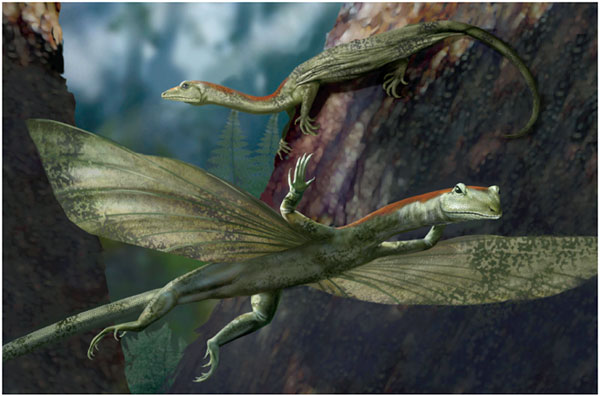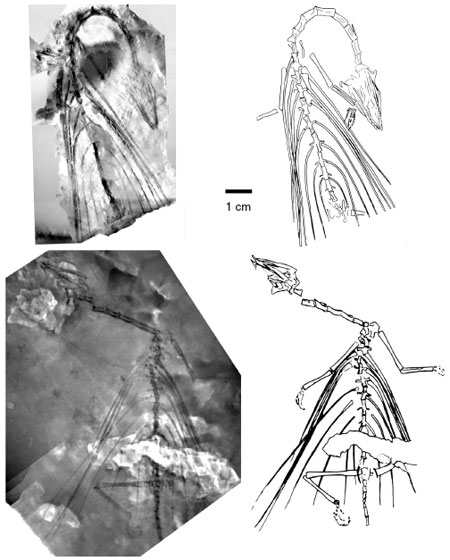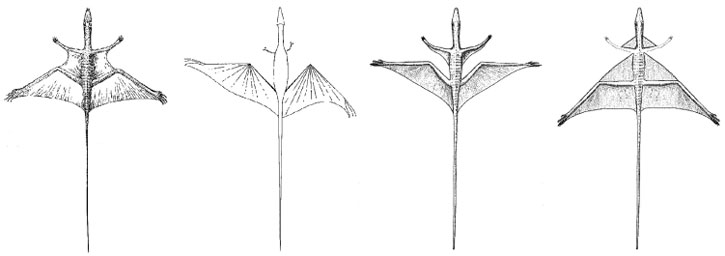Freed to Fly Again
By Pat Lee Shipman
Through CT scans that can show sub-millimeter details, an imprisoned fossil reveals its secrets
Through CT scans that can show sub-millimeter details, an imprisoned fossil reveals its secrets

DOI: 10.1511/2008.69.20
As professionals who study the past, paleontologists "read" the physical remains or traces of long-gone creatures and try to recreate their living forms. We ask how long-extinct species lived and moved, what habitats sheltered their young, what they ate, how they grew. We ponder what evolutionary pressures might have shaped the body or behavior of some species and, in some cases, driven it to extinction. But many times, the clues left behind are too scant to allow us to answer such questions with surety. How useful it would be to step into a time machine and go back to answer all our questions!

Image courtesy of Karen Carr and the Virginia Museum of Natural History.
Time machines have been part of our cultural consciousness since at least 1895, when H. G. Wells launched the discussion with his novel The Time Machine. Sir Arthur Conan Doyle took up the idea of visiting the ancient past in the 1912 novel Lost World. I often wonder how many paleontologists and paleoanthropologists were influenced, as I was, by reading these works when they were children.
Wells's book was published around the time x rays were discovered; this demonstration of uncanny powers unsettled and amazed scientists and the public. It's possible that it even helped inspire Wells's fiction. Fittingly, x rays are now becoming true time machines, peering through rocks and time as easily as they look through skin and flesh.
Most readers of this magazine will have heard of the computed tomography, or CT, scans used in healthcare settings. CT scanners use x rays to take pictures from many different angles, and a computer then combines those pictures to create a three-dimensional image. The micro-CT scanner applies the same principle on a smaller scale. It was developed largely for industrial purposes and is able to show features smaller than the width of a single hair—much more detail than a physician needs. Most "patients" studied with micro-CT are inanimate. Recently, these subjects have included fossils of animals dead for millions of years.
Paleontologist Nick Fraser of the Virginia Museum of Natural History in Martinsville, Virginia, has gotten to know all about micro-CT scans in recent years following the discovery of a unique fossil from the Solite Quarry in Virginia, a trove some 220 million years old. Fraser collaborates with Paul E. Olsen of the Lamont-Doherty Earth Observatory of Columbia University, who found the site in 1975.
The Solite Quarry is famous as a Konservatt Lagerstätte, a fossil site that shows exquisite preservation of an entire ecosystem, including the smallest and most fragile specimens. Excavations have yielded a wealth of fossilized insects, even showing the veining on the delicate wings of waterbugs or caddis flies. The rocks also contain fish, including the very primitive coelacanth, and plant remains from the damp waterside habitat, such as conifers, ferns, cycadophytes and gingko-like trees. You can find winged seeds, the kind that children often call "helicopters" or "pollynoses," that look almost as if they could have fallen from a maple tree today.
After years of revealing the litany of species in that ancient marsh, the Solite Quarry recently yielded a surprise: two specimens that preserve the features of a creature never seen or suspected to exist before. As Fraser tells the story, "It was touch and go for the specimen—certainly it was seconds away from biting the dust! I was on my own in the quarry splitting through the shale on a very hot, sultry day. Often, once the shale is split and exposed to air, the black surfaces become instantly covered with a layer of calcium carbonate, making it almost impossible to discern any fossils. This is exactly what happened with this specimen. I actually had it poised over my shoulder to throw, when the light just caught the ribs and threw them into relief. I took a second look, thought it was a coelacanth tail and put a field number on it. It was only at the end of the day when I was going through all the specimens with my field notes that I realized the 'tail' was right at the end of a small skull and long, slender neck!"
Fraser then remembered another enigmatic find he had made in 1994, which he almost threw away as unimportant. After twisting the slab of rock back and forth to get oblique lighting, he had decided there were faintly visible limbs on the slab and kept it.
"At that stage," Fraser recalls, grinning, "I thought I might have a gliding animal. Paul, on the other hand, thought I had been out in the sun too long and even questioned whether there was a fish there, let alone a glider!"
He and Olsen had never identified and studied the 1994 specimen because it was too difficult to prepare. They hoped this new specimen would answer their questions, but its preparation proved just as intractable. The surrounding stone, or matrix, was very hard and nearly the same color as the delicate fossilized bones. The danger of damaging the fossil was too great, leaving Fraser and Olsen with a serious problem. If the specimen could not be seen, then according to science it didn't exist.
At a meeting of the Society for Vertebrate Paleontologists, one of the scientists who had tried to prepare the fossil mentioned the problem to Alan Walker, a paleontologist at the Pennsylvania State University. Walker suggested that Fraser bring the specimen to the Center for Quantitative Imaging at Penn State to see what the micro-CT scanner there could do with it.
The specimen was difficult to scan because the slab containing the fossil was thin and flat. Explains Tim Ryan of the imaging center, who worked on the specimen, "CT scanners don't particularly like flat, oblong things. They much prefer cylindrical sorts of objects. It was a test of the scanner and our ingenuity that we were able to get decent data from it."
Ryan placed the slab inside a plastic tube and filled the space around the slab with florist's foam to create a cylindrical object. In the computer, Ryan was able to subtract digitally both the matrix and the foam, leaving only images of the fossilized bones.

Images courtesy of Nicholas C. Fraser.
What he and Fraser saw was an extraordinary creature about 25 centimeters long. It was a long-necked, four-legged reptile with wings. Fraser, Olsen, Alton C. Dooley, Jr. (the assistant curator of paleontology at the Virginia Natural History Museum) and Ryan named the new species Mecistotrachelos apeoros, Greek for "long-necked soarer," in the June 2007 issue of the Journal of Vertebrate Paleontology. This might be the first time that a new species has been named entirely on the basis of micro-CT images of specimens that cannot otherwise be seen.
The narrow, pointed skull of these specimens is only about two centimeters long and the neck is more than five centimeters long—unusual proportions compared with the relatively short-necked lizards of today. More startling are the bizarre, delicate ribs of Mecistotrachelos. In the 2003 specimen, these are draped along the upper spine like the ribs of a half-closed umbrella. The first rib, the one closest to the animal's head on each side, looks normal, but the next eight are exceptionally long. Some ribs are about seven centimeters—twice as long as the entire hind limb from hip to ankle.
The shape and arrangement of these bones indicate that Mecistotrachelos spread its ribs out sideways to support folds of skin that became gliding wings. Special muscles that attached to the heads of the second and third ribs manipulated the angle and curvature of the wings. These features suggest that Mecistotrachelos would have been very adept in the air.
The muscles for controlling the wings may have been especially important because of Mecistotrachelos's long neck. Many long-necked birds, such as herons, hold their necks in an S-shape when they fly, a position that helps keep the head and neck—and the rest of the body—stable in flight. Mecistotrachelos didn't have enough flexibility in its long neck to achieve this posture, so it must have glided with its neck outstretched despite the risk of crashing.
The bones of the hind foot of Mecistotrachelos are hooked for perching on vegetation, and its teeth suggest an insect diet. Although the fossils were found in what was once the deepest part of the lake, Fraser is certain they did not swim. "There is not a single aquatic adaptation in their skeletons," he says. "It seems likely that both specimens were blown off course and out over the lake, where they sank into the fine mud on the bottom and were preserved."
Part of the charm of this new species is that it is so unlike anything else. Only two other types of gliding reptiles are known from the Triassic and they are rather different. One, Sharovipteryx mirabilis or "Sharov's miraculous wing," was named after the Russian paleontologist Alexei Sharov, who described the only known specimen in 1971. It is a strange creature, with short front legs, very long hind legs and a long tail. Sharovipteryx has an especially odd anatomy, with a tiny front membrane stretched between its body and short front legs and another, much larger, triangular wing (similar to that of the Concorde supersonic jet) stretched between the tail and the long hind legs.

Image courtesy of Gareth J. Dyke.
According to an aerodynamic analysis by Gareth J. Dyke of University College Dublin and colleagues in the Journal of Evolutionary Biology in 2006, the small front wing acted like a canard to control pitch. Speed was controlled by the reptile's spreading or closing its hind legs which in turn tautened or loosened the elastic membrane between them. Sharovipteryx glided in a manner similar to a delta-wing jet—not at all like Mecistotrachelos but in a completely original fashion.
The other type of gliding reptile is best represented by the species Icarosaurus siefkeri and its close relatives. Discovered in an abandoned quarry in New Jersey by three teenaged amateur paleontologists, Icarosaurus siefkeri wasnamed both for the mythical flyer Icarus and for one of the discoverers, Alfred Siefker. Icarosaurus has a short neck and feet that are not strongly hooked like those of Mecistotrachelos. Perching on a small branch would have required muscular effort for Icarosaurus.
Both Mecistotrachelos and Icarosaurus glided on membranous wings supported by elongated ribs that could be spread laterally, but the two species had some key differences in the shape and curvature of their gliding structures. When Icarosaurus spread its ribs, the shape of the bones dictated a concave lower surface. The wings thus had a fixed curvature, or camber, in the language of aeronautics. Because of this, its aerial maneuvers were probably less controlled and less subtle than those of Mecistotrachelos. In contrast, Mecistotrachelos's ribs are straight in the portions farther away from the backbone, and the animal could have changed camber with muscles that moved the first rib on each side up or down.
A puzzling question is how—or whether—rib-gliders like Mecistotrachelos were able to breathe while gliding. Because the ribs had to remain outstretched to provide lift, they could not have moved much to pump air in and out of the lungs. Fraser guesses that Mecistotrachelos probably held its breath while in flight. Although the species is too primitive to be considered a lizard, he says, it is important to realize that "most lizards today do not breathe while they locomote—or at least there is very inefficient breathing going on—due to Carrier's constraint."
Carrier's constraint is named for David R. Carrier at the University of Utah in Salt Lake City, who observed that the typical sprawling gait of a lizard restricts the animal's ability to breathe while running or walking. As it moves, a lizard bends its body first to one side to take a step with one front leg and the opposite hind leg simultaneously. Then the animal bends its body the other way to take the next step. The lung on the bent side of the body is compressed, which squeezes the air into the opposite lung, and the next step reverses the process. Used air is shunted back and forth, and the creature never gets a chance to take a new breath. Carrier's constraint explains why these reptiles tend to have much less stamina than similar-sized mammals: Lizards simply run out of oxygen to fuel their muscles. Most are limited to short bursts of muscle-powered movement before they go into oxygen debt and must rest. By contrast, Fraser notes, "we don't think these gliders propelled themselves through the air by wiggling back and forth as if they were walking."
Some lizards take in oxygen while they are moving by gulping air into their mouths and throat sacs, a mechanism called gular pumping, and Mecistotrachelos might have done the same. It would not have needed as much oxygen while gliding as creatures require when running or walking. Fraser admits, "I am not sure how this animal with its very narrow thorax would have breathed even when the ribs were not in use for gliding."
Basic questions about the biology of these animals and the mechanics of rib-gliding remain mysterious. Apparently, this bizarre adaptation evolved twice, once in Icarosaurus and once in the unrelated Mecistotrachelos. Hind-leg gliding evolved independently in the Sharovipteryx lineage. Who would have expected gliding to be so prevalent in the Triassic? Who would have thought there were so many ways to evolve gliding anatomy?
This beautiful species represents a deliciously new kind of animal. In my years as a student of past life on Earth, I have come to believe that evolution, viewed over the span of eons, is more innovative than the most inspired human designer. Again and again, the record of the past has revealed extraordinary creatures and startling adaptations to ecological pressures no one envisioned. In this case, human cleverness, itself a product of evolution, has built a machine that parts the curtains of time and stone to show us a wonder-full, otherwise invisible, being.
Click "American Scientist" to access home page
American Scientist Comments and Discussion
To discuss our articles or comment on them, please share them and tag American Scientist on social media platforms. Here are links to our profiles on Twitter, Facebook, and LinkedIn.
If we re-share your post, we will moderate comments/discussion following our comments policy.